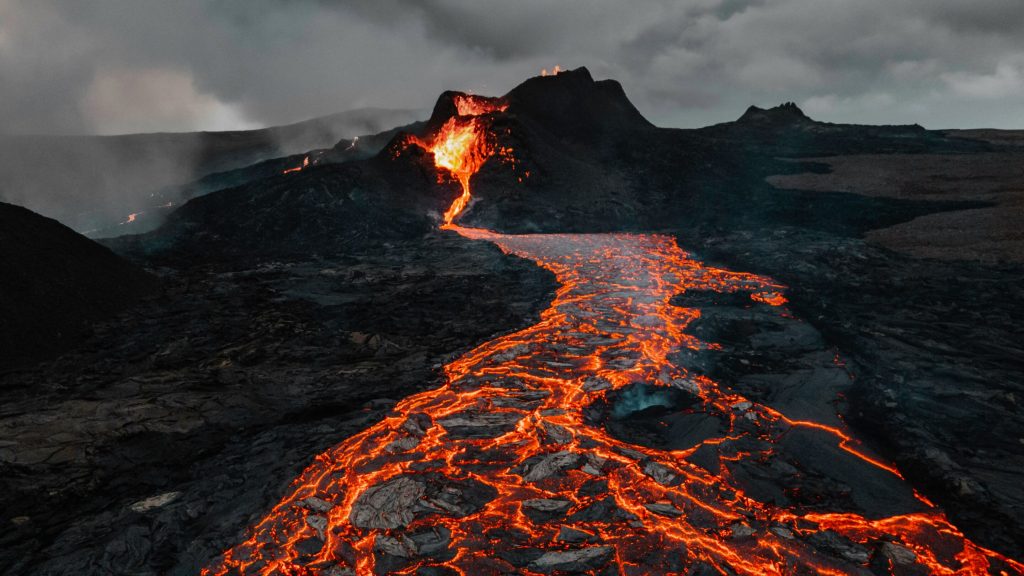Credit: Unsplash/CC0 Public Domain
New research into molten rock 20km below the Earth’s surface could help save lives by improving the prediction of volcanic activity.
Volcanic eruptions pose significant hazards, with devastating impacts on both people living nearby and the environment. They are currently predicted based on activity of the volcano itself and the upper few kilometers of crust beneath it, which contains molten rock potentially ready to erupt.
However, new research highlights the importance of searching for clues much deeper in the Earth’s crust, where rocks are first melted into magma before rising to chambers closer to the surface.
To understand the inner workings of our planet’s most explosive phenomena, researchers at Imperial College London and the University of Bristol dug deep to shed light on the frequency, composition, and size of volcanic eruptions around the world.
Their findings suggest that the size and frequency of eruptions are closely linked to the time it takes for extremely hot, molten rock known as magma to form in these deep reservoirs beneath the Earth’s crust—at depths of up to 20 kilometers—as well as to the size of these reservoirs.
Researchers believe that the findings, published in Science Advances, will allow them to predict volcanic eruptions more accurately, ultimately safeguarding communities of people and helping mitigate risks to the environment.
Studying volcanoes around the world
The study, led researchers at the Department of Earth Science and Engineering at Imperial, reviewed data from 60 of the most explosive volcanic eruptions, spanning nine countries: the United States, New Zealand, Japan, Russia, Argentina, Chile, Nicaragua, El Salvador and Indonesia.
Study author Dr. Catherine Booth, Research Associate in the Department of Earth Science and Engineering at Imperial College London, said, “We looked at volcanoes around the world and dug deeper than previous studies that focused on shallow underground chambers where magma is stored before eruptions. We focused on understanding magma source reservoirs deep beneath our feet, where extreme heat melts solid rocks into magma at depths of around 10 to 20 kilometers.”
The team combined real-world data with advanced computer models. They looked at the composition, structure, and history of rocks deep beneath the Earth’s crust, alongside information gathered from active volcanoes, to understand how magma builds up and behaves deep underground, eventually rising through the Earth’s crust to volcanoes.
Using this information, researchers created computer simulations that mimic the complex processes of magma flow and storage deep within the Earth. Through these simulations, the team gained new insights into what factors drive volcanic eruptions.
Identifying key controls of eruptions
“Contrary to previous beliefs, our study suggests that the buoyancy of the magma, rather than the proportion of solid and molten rock, is what drives eruptions,” said Dr. Booth.
“Magma buoyancy is controlled by its temperature and chemical composition compared to the surrounding rock– as the magma accumulates its composition changes to make it less dense, making it more ‘buoyant’ and enabling it to rise.
“Once the magma becomes buoyant enough to float, it rises and creates fractures in the overlying solid rock—and it then flows through these fractures very rapidly, causing an eruption.”
As well as identifying buoyancy of magma as an important factor driving eruptions, researchers also looked at how magma behaves once it reaches shallower underground chambers right before erupting. They found that how long magma was stored in these shallower chambers can have an effect on volcanic eruptions too—with longer periods of storage leading to smaller eruptions.
While larger reservoirs may be expected to fuel greater, more explosive eruptions, the findings also revealed that very large reservoirs disperse heat, which slows down the process of melting solid rocks into magma. This led researchers to conclude that the size of reservoirs is another key factor for predicting eruption sizes accurately—and that there is such a thing as an optimal size for the most explosive eruptions.
Findings also highlight that eruptions are rarely isolated and, instead, are part of a repetitive cycle. Additionally, the magma released by the volcanoes they studied was high in silica, a natural compound known to play a role in determining the viscosity and explosiveness of magma—with high-silica magma tending to be more viscous and resulting in more explosive eruptions.
Next steps
Co-author Professor Matt Jackson, Chair in Geological Fluid Dynamics in the Department of Earth Science and Engineering at Imperial College London, said, “By improving our understanding of the processes behind volcanic activity and providing models that shed light on the factors controlling eruptions, our study is a crucial step towards better monitoring and forecasting of these powerful geological events.
“Our study had some limitations: our model focused on how magma flows upwards, and the source reservoirs in our model contained only molten rock and crystals. However, there is evidence that other fluids such as water and carbon dioxide are also found in these source reservoirs, and that magma can swirl and flow sideways.”
The next steps for researchers will be to refine their models, incorporating three-dimensional flow and accounting for different fluid compositions. In this way, they hope to continue to decipher the Earth’s processes responsible for volcanic eruptions—helping us better prepare for natural disasters in the future.
More information: Catherine Booth et al, Source reservoir controls on the size, frequency and composition of large-scale volcanic eruptions, Science Advances (2024). DOI: 10.1126/sciadv.add1595. www.science.org/doi/10.1126/sciadv.add1595
Provided by Imperial College London
Citation: Clues from deep magma reservoirs could improve volcanic eruption forecasts (2024, May 10) retrieved 17 July 2024 from https://phys.org/news/2024-05-clues-deep-magma-reservoirs-volcanic.html
This document is subject to copyright. Apart from any fair dealing for the purpose of private study or research, no part may be reproduced without the written permission. The content is provided for information purposes only.

